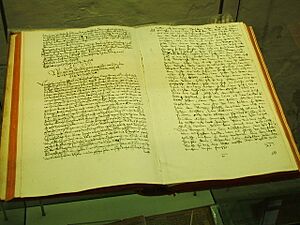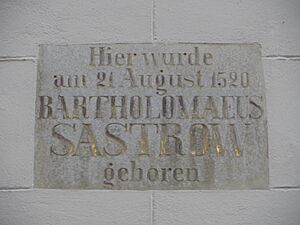Bartholomäus Sastrow facts for kids
Bartholomäus Sastrow (born August 21, 1520 – died February 7, 1603) was an important German official. He worked as a notary and later became the mayor of Stralsund. When he was 75 years old, he wrote a very important book about his own life. This book helps us understand what life was like in his time. You can find a special sign (plaque) where he was born in Greifswald.
Contents
The Life of Bartholomäus Sastrow
Early Life and Family
Bartholomäus Sastrow was born in Greifswald. His father, Nicolaus Sastrow, was a merchant. His mother, Anna Schmiterlow, was related to Nikolaus Smiterlow, who was the mayor of Stralsund. Bartholomäus was the third of eight children. Sadly, four of his younger sisters and his mother died during a sickness in 1549 or 1550. Only Bartholomäus, his older sister Anna, and his brother Karsten lived long lives. His older brother Johannes became a lawyer and poet, but he died young.
Around 1523, Bartholomäus's father had to leave Greifswald after a serious argument. He moved to Stralsund. At the same time, his uncle Nikolaus Smiterlow left Stralsund for political reasons and stayed with Bartholomäus's mother in Greifswald. Smiterlow's strong Protestant faith and his dislike for trouble greatly influenced Bartholomäus. When Smiterlow returned to Stralsund in 1527, Bartholomäus's mother and her children also moved there to be with her husband. However, Bartholomäus stayed in Greifswald with his grandfather until 1529.
In 1533, Bartholomäus's father became a leader (alderman) in the Tailors' Guild. The Reformation (a big change in religion) had already reached Stralsund in 1525, but Greifswald became Protestant later, in 1531. So, the family likely became Protestant when they moved to Stralsund.
Education and Early Career
In 1538, Sastrow started studying at the University of Rostock for about a year. In 1541, he continued his studies at the new University of Greifswald. There, he learned a lot about history, Greek, and Latin. But he had to leave before finishing his studies. This was because of problems in Stralsund caused by the Mayor of Lübeck, Jürgen Wullenwever. These problems led to his father and uncle being put under house arrest, which caused money problems for the family.
In 1542, Bartholomäus and his brother Johannes traveled to Speyer. They hoped to find work and help with a court case about the argument his father had 20 years earlier. They found the main court (the Imperial Chamber Court) was not working. However, with help from important people like Martin Luther and Philipp Melanchthon, Bartholomäus got a job as a clerk. Even though he didn't finish his university studies, he became a certified notary for the Holy Roman Empire in 1544. In 1545, even though he was a Lutheran Protestant, he started working for the Knights of St. John in Nieder-Weisel.
Travels and Return Home
His brother Johannes died in Italy in 1545. So, Bartholomäus went to Italy the next year to sort out his brother's affairs. In Rome, he felt sick from the heat and was worried about being found out as a Protestant by the Inquisition. So, he left Italy quickly, even though he was offered a good job. He and a friend traveled disguised as Italians to avoid soldiers who were fighting Protestants. Later, they changed back to their normal clothes to avoid German Protestants who might not understand their strange accents.
When he returned, Sastrow worked in Wolgast for the Dukes of Pomerania, Philip I and Barnim XI. He also went on diplomatic trips to Bohemia and Saxony. He attended an important meeting called the Diet of Augsburg in 1547/48. In 1548, he became Pomerania's representative at the Imperial Chamber Court in Speyer. This was when he finally managed to help his father with the old court case. While in Speyer, he also traveled and visited the famous mapmaker Sebastian Münster in Basel.
Becoming Mayor of Stralsund
Sastrow was not happy with the court's slow process. In the early 1550s, he decided to work for himself. He left the dukes' service and became a notary for the Imperial Chamber Court in 1552. He first returned to Greifswald and then, in 1555, moved back to Stralsund. He helped the mayor, Nikolaus Gentzkow, create new rules for schools, churches, and the town's laws.
In 1562, he was chosen to be on the city council. In 1578, he became mayor of Stralsund and stayed in that job until he died in 1603. His time as mayor had many political and religious disagreements. Sastrow was very firm in his beliefs, which sometimes made him enemies.
He was married twice. He had three children with his first wife, Catharina Frubose: Katharina, Amnestia, and Johannes. A month after Catharina died in 1598, he married her maid, Anna Haseneier.
His Amazing Autobiography
What is an Autobiography?
An autobiography is a book someone writes about their own life. In 1595, when he was 75 years old, Sastrow wrote his autobiography. He used many different things to help him write it. He used his own diaries and letters. He also used official papers he had access to as a notary. He even used other history books and biographies of people like the previous mayor, Franz Wessel.
Why His Book is Important
Sastrow's autobiography is a very important book from the 16th century. It helps us learn about history. For example, his book is one of the first or only records of events like the conflict between Philip I, Landgrave of Hesse and the Emperor. This conflict led to Philip being put in prison. The book also includes many legal documents. These documents are important for understanding the history of the Holy Roman Empire, especially the 1547/48 Diet of Augsburg and the Augsburg Interim of 1548.
However, Sastrow only wrote about things he personally experienced. So, there are some parts of history from that time that his book doesn't cover. The book was not written in Latin, which was common for educated people then. Instead, it was written in a type of German called Early New High German Kanzleisprache. This was the language used for official documents and court records.
Sastrow divided his book into four parts. The last part, which was about his time in Stralsund, is missing. We don't know if he never finished it or if it was destroyed. Some people think it might have been destroyed because he called his time there "the Devil's bathhouse." He didn't write much about his family in the book, which shows it wasn't meant to be just a private diary.
Where to Find His Book
The original handwritten copy of Sastrow's autobiography is kept at the City Archives of Stralsund. You can see it on display at the Kulturhistorisches Museum Stralsund.



